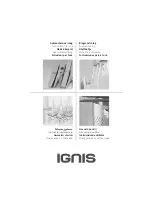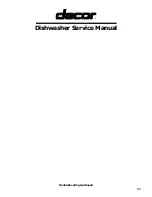
Below are step-by-step instructions to help you achieve
the best possible dishwashing results.
1
Load the baskets correctly
Do not rinse dishes under running water before
loading them in the dishwasher. Simply scrape off
large food particles before loading the dishwasher.
See the section Fragile dishes if you want to wash items
that may be considered fragile.
Upper basket and knife basket
Place glasses, cups, bowls, side plates, and saucers in
the upper basket. Wine glasses are placed on the wine
glass shelf (if fitted). Place sharp knives in the special
knife basket at the top of the dishwasher, or in the knife
stand on the right (if equipped).
NOTE!
All dirty surfaces should face in and down!
Lower basket
Place plates, side plates, serving dishes, pots, and cutlery
(in the cutlery basket) in the lower basket. Lower the
fold-down plate supports when washing pots.
Cutlery basket
Place cutlery with the handles facing down, except for
knives, and spread them out as much as possible. Ensure
that spoons do not stack inside each other. The cutlery
basket is placed in the lower basket.
WARNING!
Knives and other pointed items must be placed with the
points down in the cutlery basket or horizontally in other
baskets.
Do not place cutlery made of different materials, such as
silver and stainless steel, in the same place (risk of
discoloration).
The cutlery basket has a fold-down section in the middle
for small items, or small shafts, such as electric whisk
attachments.
2
Check that the spray arms can
rotate freely
3
Add detergent
We recommend that you use only unscented,
granular automatic dishwashing detergent. Using
the wrong detergent could cause flooding and/or damage
your dishwasher. Do not use detergent that has been wet
and is clumped. Also, check the expiration date on the
container.
The amount of detergent needed can vary due to
differences in water hardness. To determine the water
hardness in your area, contact your local water utility or
area water softening company. The harder the water, the
more detergent you may need. Refer to the chart below
for the recommended detergent amounts based on water
hardness. Remember, you should adjust the amount of
detergent you use by small amounts until you find the
correct amount. Twelve grains and higher is extremely
hard water and detergent alone may not be enough. You
may need to use a water softener to maximize the
performance of your dishwasher. Also, in areas with hard
water (9+) you may need to wash at lower temperatures
to prevent hard water deposits from forming in tank and
wash system. In hard water areas, both the dishes and
the machine can develop a white or gray film after a while.
If this happens, run the Platters & Pans program with high
temperature and two tablespoons of citric acid or
commercially available dishwasher cleaner in the
detergent compartment (with no dishes in the machine).
Customer Care Center
14
1-800-898-1879
www.askousa.com
Dishwashing















































